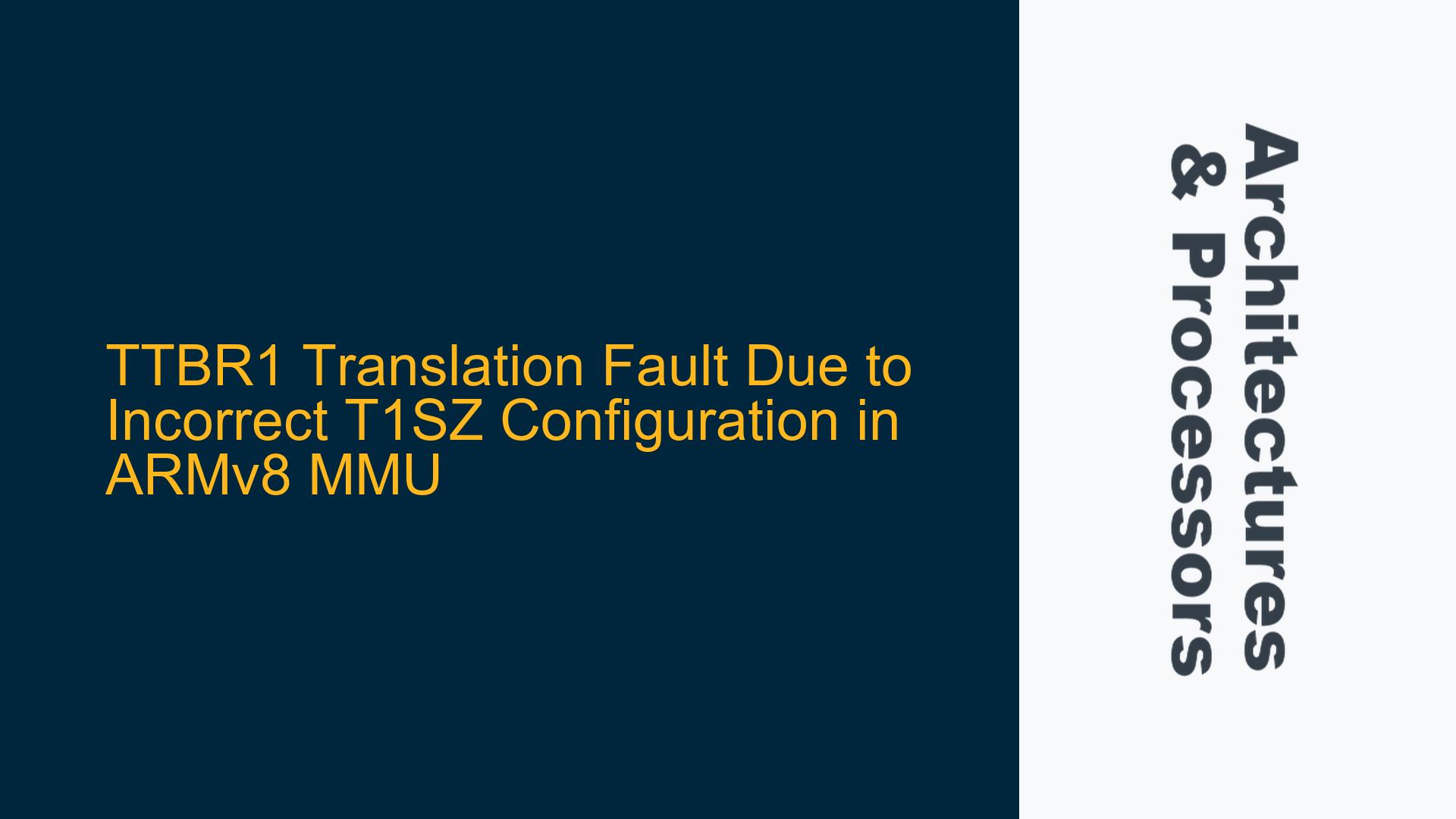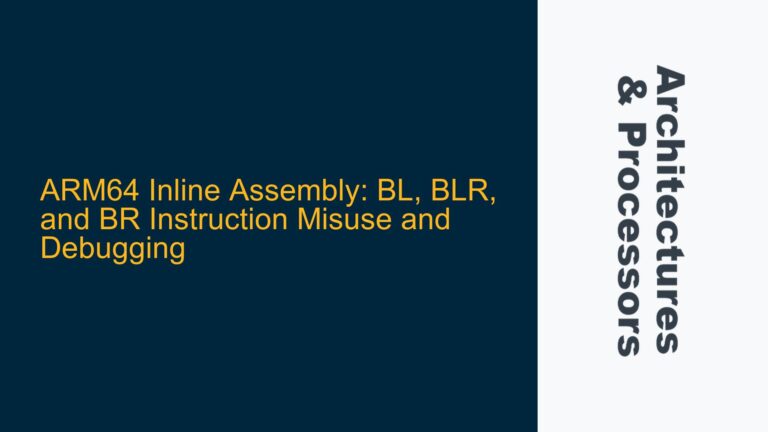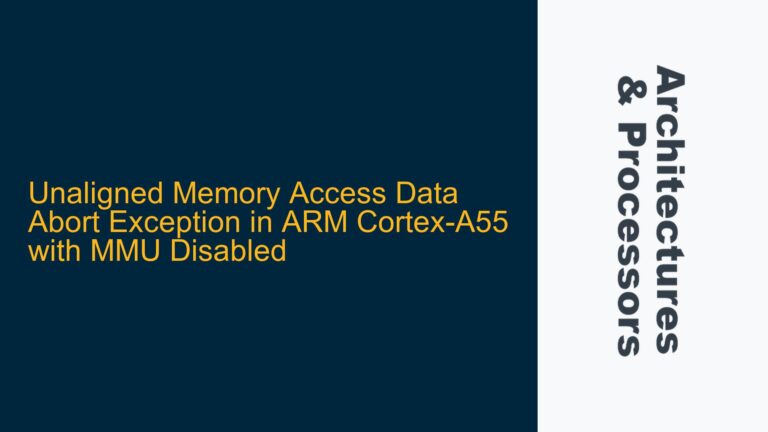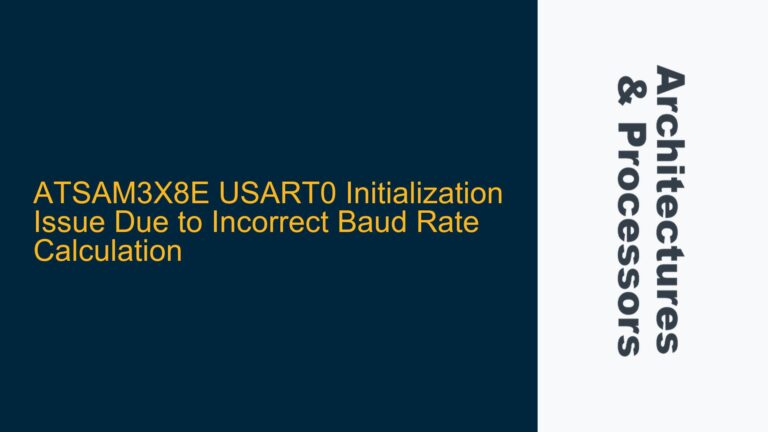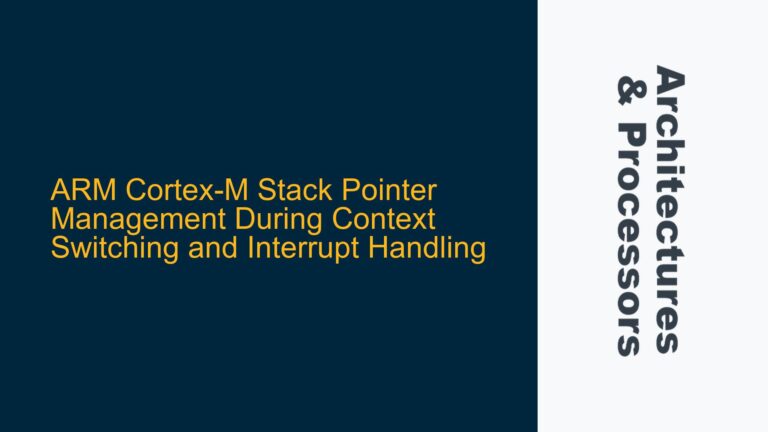ARMv8 MMU Identity Mapping and TTBR1 Translation Fault
The ARMv8 architecture introduces a sophisticated Memory Management Unit (MMU) that supports two translation table base registers (TTBR0 and TTBR1) to manage virtual-to-physical address translations. TTBR0 is typically used for the lower virtual address range, while TTBR1 is used for the upper virtual address range. The boundary between these two ranges is controlled by the Translation Control Register (TCR), specifically the T1SZ field. A common issue arises when developers attempt to use TTBR1 for identity mapping but encounter a translation fault due to incorrect configuration of the T1SZ field. This fault occurs because the upper virtual address range is not properly defined, leading to an invalid translation when accessing memory through TTBR1.
In an identity mapping scenario, the virtual address is identical to the physical address. This is often used during the early stages of bootloading or when transitioning between different memory management configurations. When TTBR0 is configured correctly, accessing memory through the lower virtual address range works as expected. However, when attempting to access the same physical memory through TTBR1 by modifying the most significant bits of the virtual address, a translation fault can occur if the T1SZ field in the TCR is not set correctly. This field determines the size of the upper virtual address range, and if it is too small, the MMU will fail to translate the address, resulting in a fault.
Misconfigured T1SZ Field and VA Range Boundary
The root cause of the TTBR1 translation fault lies in the misconfiguration of the T1SZ field in the TCR. The T1SZ field specifies the size of the upper virtual address range by defining the number of bits that are ignored in the address translation process. In ARMv8, the virtual address space is divided into two regions: the lower region (controlled by TTBR0) and the upper region (controlled by TTBR1). The boundary between these regions is determined by the T1SZ and T0SZ fields in the TCR. The T0SZ field defines the size of the lower region, while the T1SZ field defines the size of the upper region.
When the T1SZ field is set incorrectly, the upper virtual address range becomes too small, causing the MMU to interpret addresses in the upper range as invalid. This results in a translation fault when attempting to access memory through TTBR1. For example, if the T1SZ field is set to a value that limits the upper virtual address range to a size smaller than the address being accessed, the MMU will fail to translate the address, leading to a fault. This issue is particularly common when developers attempt to use identity mapping with TTBR1 without fully understanding the relationship between the T1SZ field and the virtual address range.
The TCR also includes other fields that influence the address translation process, such as the TG1 and TG0 fields, which define the granule size for the upper and lower regions, respectively. However, the T1SZ field is the primary culprit in this scenario. The granule size determines the size of the pages used in the translation tables, but it does not directly affect the size of the virtual address range. Therefore, while it is important to configure the granule size correctly, the T1SZ field must be given special attention when setting up TTBR1 for identity mapping.
Correcting T1SZ Configuration and Implementing Proper VA Range Management
To resolve the TTBR1 translation fault, the T1SZ field in the TCR must be configured correctly to define an appropriate upper virtual address range. The first step is to determine the desired size of the upper virtual address range. In ARMv8, the virtual address space is 48 bits wide, and the T1SZ field specifies the number of bits that are ignored in the upper range. The formula to calculate the size of the upper virtual address range is:
Upper VA Range Size = 2^(64 - T1SZ)
For example, if the T1SZ field is set to 16, the upper virtual address range will be 2^(64 – 16) = 2^48 bytes, which is the maximum size for a 48-bit virtual address space. However, if the T1SZ field is set to a larger value, the upper virtual address range will be smaller. For instance, setting T1SZ to 32 will result in an upper virtual address range of 2^(64 – 32) = 2^32 bytes.
Once the desired size of the upper virtual address range is determined, the T1SZ field can be configured accordingly. This involves writing the appropriate value to the TCR. The following steps outline the process:
-
Calculate the T1SZ Value: Determine the number of bits to be ignored in the upper virtual address range based on the desired size. For example, if the upper virtual address range should be 2^48 bytes, the T1SZ field should be set to 16.
-
Update the TCR: Write the calculated T1SZ value to the TCR. This can be done using the
MSRinstruction in ARMv8 assembly. For example, if the T1SZ value is 16, the following assembly code can be used to update the TCR:MOV X0, #16 MSR TCR_EL1, X0 -
Verify the Configuration: After updating the TCR, verify that the T1SZ field has been set correctly by reading the TCR back and checking the value of the T1SZ field.
-
Test the Configuration: Access memory through TTBR1 using the modified virtual address and verify that the translation fault no longer occurs. If the fault persists, double-check the T1SZ value and ensure that the upper virtual address range is large enough to accommodate the addresses being accessed.
In addition to configuring the T1SZ field, it is also important to ensure that the translation tables for TTBR1 are set up correctly. The translation tables must include valid entries for the virtual addresses being accessed, and the page tables must be properly aligned according to the granule size specified in the TCR. The following steps outline the process of setting up the translation tables for TTBR1:
-
Allocate Memory for Translation Tables: Allocate memory for the translation tables used by TTBR1. The size of the translation tables depends on the granule size and the size of the virtual address range.
-
Initialize Translation Tables: Populate the translation tables with valid entries that map the virtual addresses to the corresponding physical addresses. For identity mapping, the virtual addresses should be identical to the physical addresses.
-
Set TTBR1: Write the base address of the translation tables to TTBR1. This can be done using the
MSRinstruction in ARMv8 assembly. For example, if the base address of the translation tables is stored in register X1, the following assembly code can be used to set TTBR1:MSR TTBR1_EL1, X1 -
Enable MMU: Enable the MMU by setting the appropriate bits in the System Control Register (SCTLR). This can be done using the
MSRinstruction in ARMv8 assembly. For example, the following assembly code can be used to enable the MMU:MRS X0, SCTLR_EL1 ORR X0, X0, #1 MSR SCTLR_EL1, X0
By following these steps, the T1SZ field in the TCR can be configured correctly, and the translation tables for TTBR1 can be set up to enable successful address translation. This will resolve the TTBR1 translation fault and allow memory to be accessed through the upper virtual address range without issues.
Conclusion
The TTBR1 translation fault in ARMv8 MMU is a common issue that arises when the T1SZ field in the TCR is misconfigured, leading to an invalid upper virtual address range. By understanding the relationship between the T1SZ field and the virtual address range, developers can correctly configure the TCR and set up the translation tables for TTBR1 to enable successful address translation. Properly managing the virtual address range and ensuring that the translation tables are correctly populated are essential steps in resolving the TTBR1 translation fault and achieving reliable memory access through the upper virtual address range.
